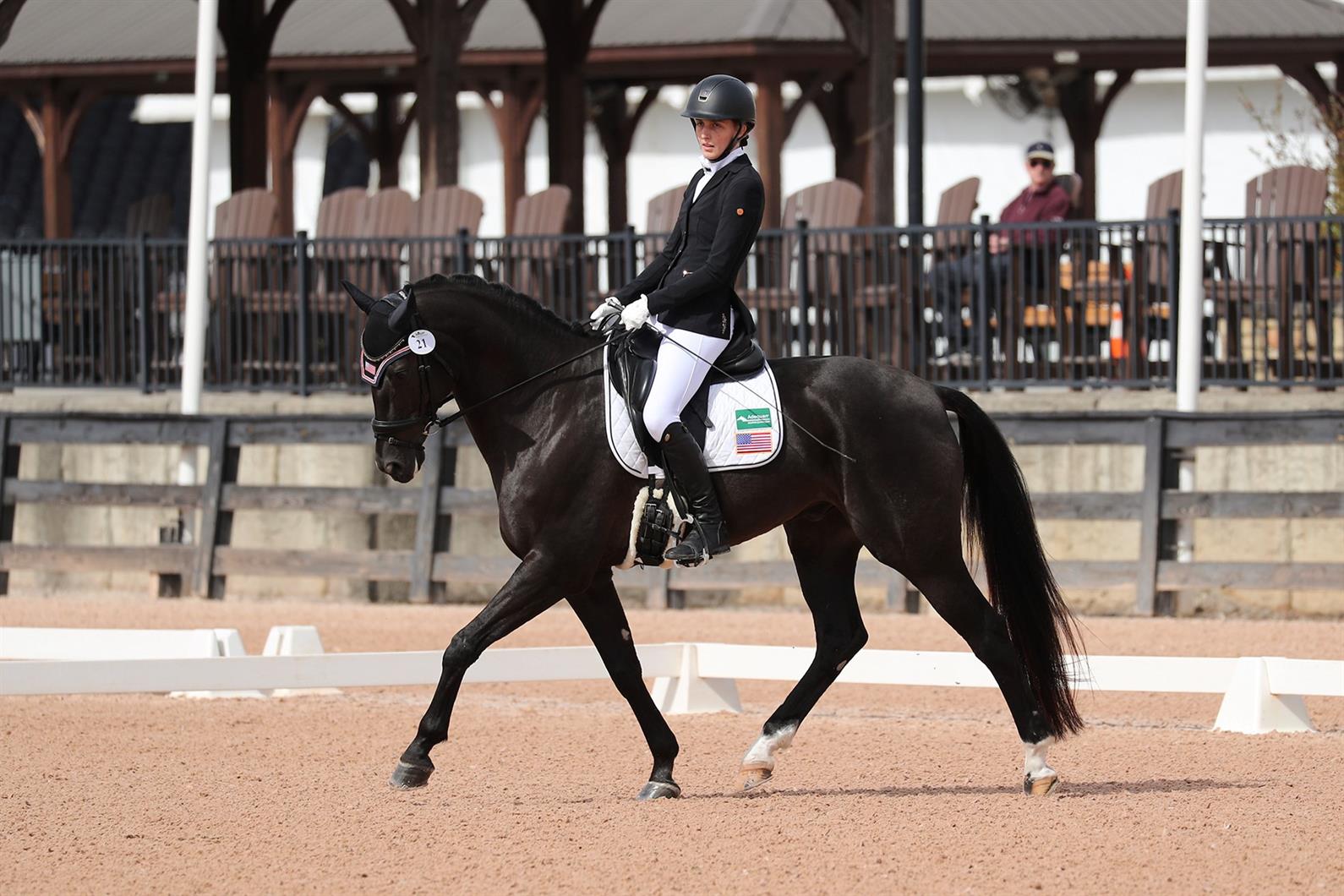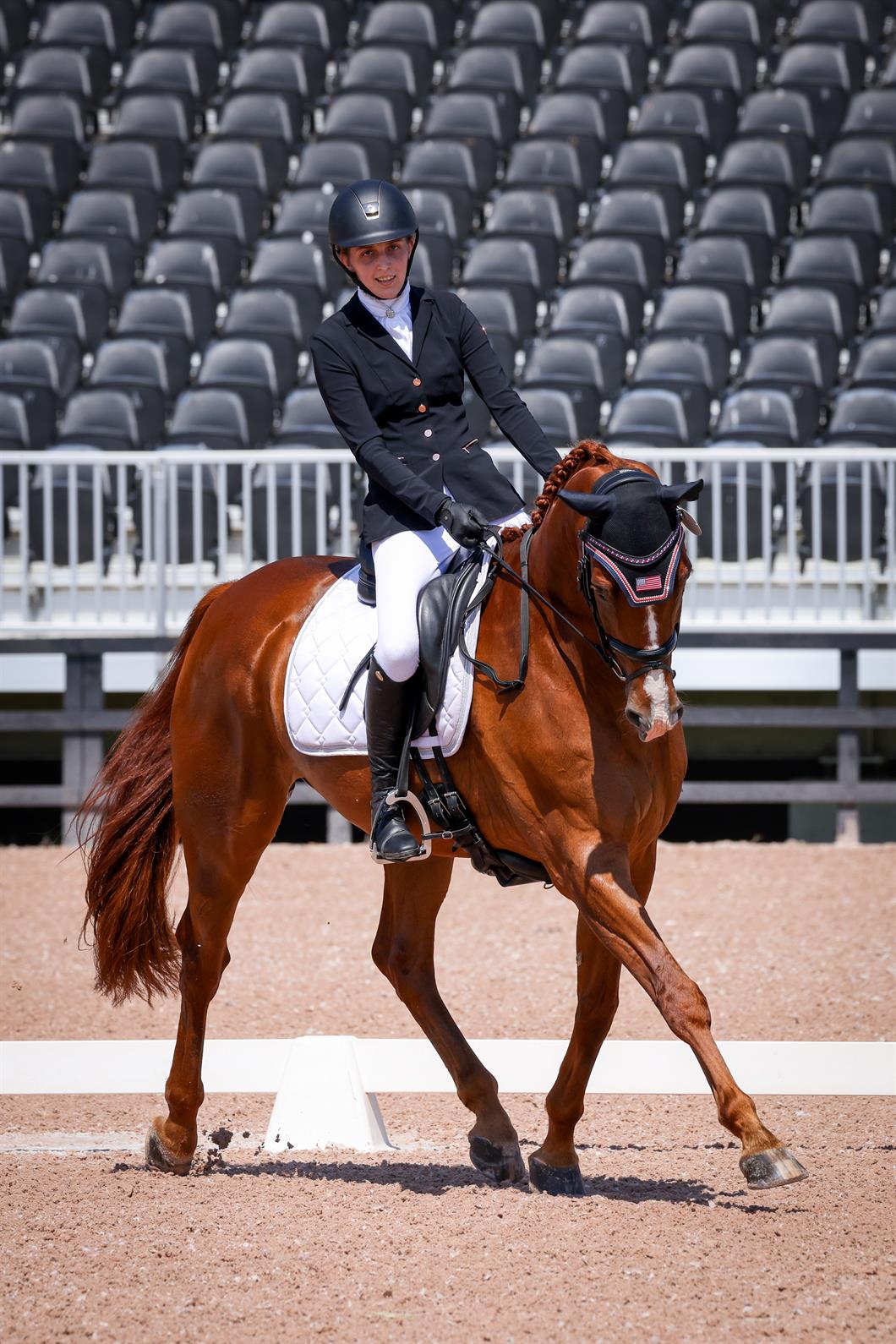U.S. Para Dressage athlete Fiona Howard has a new horse, Jagger. And with Jagger she has a partner to pursue her goal of qualifying for the U.S. Para Dressage Team for the Paris 2024 Paralympics. It’s a lofty goal, but given the challenges Howard has surmounted, doubt does not enter the picture.
Howard’s riding career began in Great Britain. Born and raised in England with an American mother and a British father, she started her equestrian exploits with her first pony when she was three. Pony Club followed with show jumping, eventing, polocrosse, and polo. Eventually, a family friend’s stable of reining horses piqued her interest. When she had the opportunity to qualify for the FEI European Reining Championships for Juniors and Young Riders, Howard switched her tack to focus on reining.

Photo: Sharon Packer
As part of the British Junior Reining Team, Howard was 14 and the youngest rider in the competition when she earned a bronze medal at the 2013 FEI European Reining Championships for Juniors and Young Riders. She rode in the 2014 and 2015 National Reining Horse Association European Affiliate Championships and competed again as a junior in the FEI European Reining Championships in 2016.
Howard immigrated to the U.S. in 2016 and rode in her first Para Dressage tests in 2021 at schooling shows. Now coached by Paralympian and 2022 FEI Para Dressage World Championship medalist Kate Shoemaker, Howard returned to the FEI arena as a Grade II para dressage athlete in 2022 at the Perrigo CPEDI3* at the Tryon Summer Dressage with De Nouvelle Vie; the pair placed second behind Beatrice de Lavalette and Sixth Sense in the Grade II Freestyle, Individual, and Team tests.
Howard recently completed an undergraduate degree in psychology, including pre-med requirements, from Northeastern University in 2021. Currently, she works remotely as a research assistant at Boston Children’s Hospital.
We caught up with her to talk about Jagger, her life in the saddle, and what her former days as a reining athlete have contributed to her current success in Para Dressage.
First things first: tell us about Jagger.
Jagger is a 16.1-hand Westphalian gelding. He’s at my coach Kate Shoemaker’s barn in Wellington. The plan for him is to show at FEI CPEDI3* shows.
The first ride I had on him was at the White Fences Summer Fun IV show and we were able to buy him afterward. He has such a great mind. He had never done para before, and despite my lack of leg, he worked hard to understand what I was asking. Kate rides him and helps me a lot with him. I try to ride every other day. We are working on what compensating aids work best with him and schooling the different parts of my tests. Around the barn, his favorite treat is probably bananas or the German muffins, although he truly eats everything.
How has your condition impacted your life?
I have dystonia, which is a neuromuscular disease. I started showing symptoms at 11 years old. Basically, my muscles involuntarily contract and twist and are very tight. The more I move them the worse it gets. It twists my bones and that affects my legs, arms, trunk, and pelvis. When I ride, I can't use my legs to give effective leg aids. And with my hands, I have a lot of tremors. So I have compensating aids, which are super helpful.
As I got older, I lost more and more the ability to walk independently, to move independently. I watched everyone running, jumping, and I couldn't do those things. And that was tough.
Horses had always been in my life and riding was the one time where I felt like I was like everyone else. I can borrow the legs I don't have. It's a different level of moving I don't get with my own body.
When I came from England to Boston Children’s Hospital at the end of 2016, I had a lot of issues going on, not just my neuromuscular condition. All my organs were struggling. I was very sick and I went through a number of surgeries. Since the end of 2016, I’ve spent 836 days in the hospital.
Describe your transition back to riding.
As my disease progressed, I started watching the Adequan® U.S. Para Dresssage Team. I watched Kate on Solitaer 40, the horse she rode in Tokyo. I watched videos of Kate and our para dressage team while I sat in the hospital, and I knew I really wanted to do that, to get back to riding. I had long discussions with my medical team.
Sports have always been such an important part of my life, even mentally and emotionally. I told them I wanted to start riding; it wasn't like I chose to stop.
I’m lucky I’m at a hospital that works with para athletes. My team was like, 'We'll do this, we'll adapt and find a way to make it work so we can manage your health and the horses."

Photo: Leslie Potter/US Equestrian
How did you start riding again?
I found Harmony Horse Stable in Littleton, Mass. During the summer of 2021, I rode in a couple of para dressage tests at schooling shows. That’s when I decided to do para seriously and be the best I can be. Harmony Horse was great at telling me, “We love having you here, but you can go farther, and we want you to go farther, but you need to be in Florida.”
I went down to Wellington last March for my USEF and FEI Para Equestrian Dressage classifications and was placed in Grade II. While there, I borrowed It’s All Good for the classifications and rode him in the Adequan® Global Dressage Festival 9. I moved to Wellington in April and was able to borrow It’s All Good for World Equestrian Center Dressage III.
I’ve been working with Kate Shoemaker since June. I borrowed De Nouvelle Vie, who has an FEI passport, to compete in the Tryon CPEDI3*.
What does returning to the FEI arena mean to you?
Returning to FEI-level competition was an important moment for me. Coming out of the arena after my first test at the Tryon CPEDI in June, I could finally look back on the journey I’ve been on in the past five or six years with the progression of my health and say, “I made it.”
I took something, my health, that looked terrifying and discouraging and proved to myself that it didn’t need to be my entire story. It also didn’t need to be the end of my story!
At first everyone spoke about how much my conditions would take away from my life and for a while the focus was just surviving. I’ve always said, “I want to be the author of my own story.” By returning to FEI-level competition, even in a different discipline, I have shown that despite the challenges I have faced, I can choose how I work through each one of them.
Continuing to compete at the FEI level is a huge motivator for me. I think my medical team would agree that it’s been a large part of what motivates me, especially when recovering from surgeries or procedures. The journey back to FEI-level competition has taught me a lot about my own strength and perseverance.
Are you using any skills from reining in your dressage?
I’m glad that reining gave me a strong seat and good balance, because I struggle with my legs that try to turn inwards, backwards, and twist. Years of reining really helped me with that. And reining patterns are about geometry—that’s helped me with figuring out test accuracy.
What’s your upcoming competition schedule look like?
Next January I intend to show in the Global Dressage Festival CPEDI in Wellington. Then I hope to go to Europe to spend some time training and showing.
What about life goals?
I want to ride as long and as far as I am able.
Cheesy as it sounds, my life goal is to live life to the fullest. I learned early on to not take anything for granted.
I also want to find a career path helping people. I love kids and working with complex, chronically ill kids. I've done public speaking at elementary schools for special education kids and volunteered at camps for chronically ill children. I want to give back as much as I can because I know how hard, how tough it can be going through childhood being different.
Learn more about Para Dressage on US Equestrian's Para Equestrian page and by visiting the United States Para Equestrian Association at uspea.org.


